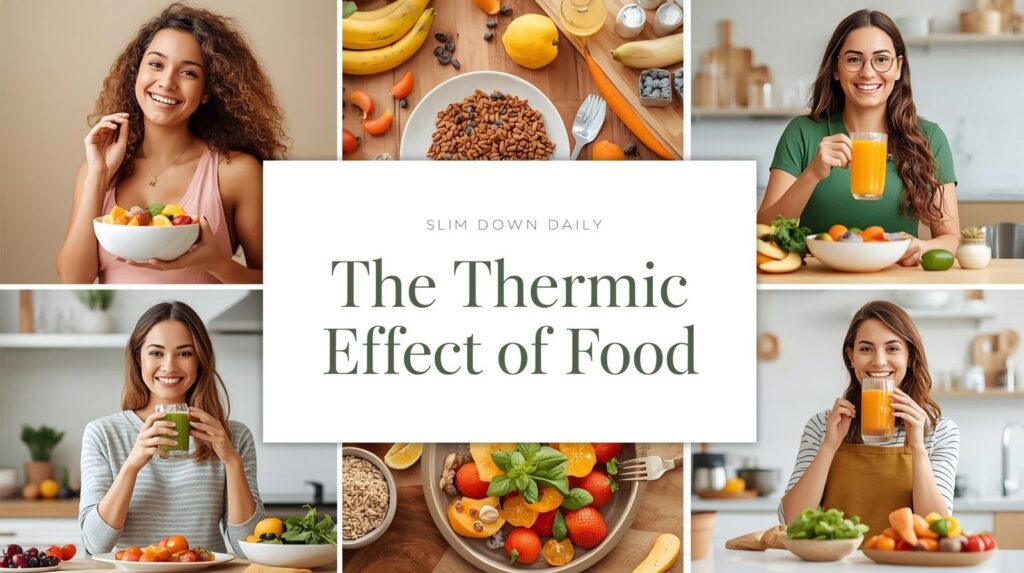The Thermic Effect of Food: How Your Body Burns Calories While Digesting
🔥 What if your body could burn calories just by eating? The Thermic Effect of Food (TEF) is the hidden metabolic boost that happens every time you digest a meal. This article breaks down how TEF works, which foods maximize it, and how you can use this science to support sustainable weight loss. From high-protein meals to fiber-rich snacks, you’ll discover how smart food choices can help you burn more calories—without spending extra time at the gym. With charts, timelines, and real-life examples, this guide turns every bite into a metabolic advantage. 🧠🥗📈

🔥🥗 The Thermic Effect of Food: How Your Body Burns Calories While Digesting
What if you could burn calories just by eating? Sounds too good to be true—but it’s not. Welcome to the Thermic Effect of Food (TEF), the hidden metabolic boost your body gets every time you digest a meal.
In this guide, we’ll explore how TEF works, which foods maximize it, and how you can use this science to support your weight loss goals. Whether you’re counting macros or just curious, this post will help you eat smarter—not less.
🧠 What Is the Thermic Effect of Food (TEF)?
TEF refers to the energy your body uses to digest, absorb, and metabolize nutrients. In other words, your body burns calories just by processing food.
🔍 TEF Breakdown:
- Digestion 🧪
- Absorption 💧
- Transport 🚚
- Storage 🏦
📉 Fact: TEF accounts for about 10% of your total daily energy expenditure (TDEE).

📊 Graph: Components of Total Daily Energy Expenditure

Here it is! 📊 The “Components of Total Daily Energy Expenditure” graph is now ready to elevate your blog post on the Thermic Effect of Food.
🔍 What It Shows:
- X-axis: Energy Components
- 🔵 Basal Metabolic Rate (BMR)
- 🟢 Physical Activity
- 🔴 Thermic Effect of Food (TEF)
- Y-axis: Percentage of Total Calories Burned
- 📈 Bar Heights:
- BMR: ~65%
- Physical Activity: ~25%
- TEF: ~10%
💡 Why It Matters:
This visual helps readers understand that most calories are burned at rest, not just through exercise. It sets the stage for your discussion on TEF by showing how digestion contributes meaningfully to daily energy expenditure—even if it’s often overlooked.
💡 Insight: While TEF is smaller than BMR or exercise, it’s still a meaningful contributor to your daily calorie burn.
🍽️ How Different Nutrients Affect TEF
Not all foods are created equal when it comes to thermic effect. Some require more energy to digest than others.
| Macronutrient | TEF Range | Why It’s High/Low |
|---|---|---|
| Protein 🥩 | 20–30% | Complex structure, high metabolic cost |
| Carbohydrates 🍞 | 5–10% | Moderate digestion effort |
| Fats 🧈 | 0–3% | Easy to digest, low thermic cost |
| Fiber 🥦 | Varies | Adds digestive effort, boosts TEF indirectly |
📌 Tip: Protein-rich meals burn more calories during digestion than fat-heavy ones.
📉 Chart: TEF by Macronutrient Type

✅ The graph “TEF by Macronutrient Type” is now ready to power up your post on how digestion burns calories!
📊 What It Shows:
- Protein: Burns approximately 25% of its calories during digestion
- Carbohydrates: Burn around 10%
- Fat: Burns only about 3%
💡 Why It Matters:
This visual makes it crystal clear—protein is the metabolic powerhouse when it comes to the Thermic Effect of Food (TEF). It takes more energy to break down, absorb, and metabolize protein than carbs or fats, which is why high-protein diets often support better fat loss and satiety.
🧠 Key Insight: If your goal is weight loss, prioritizing protein-rich meals can help you burn more calories passively—just by eating.
🧠 Interpretation: A 300-calorie protein meal could burn up to 75 calories just through digestion!
🥗 Foods That Maximize TEF
✅ High-TEF Foods:
- Lean meats (chicken, turkey) 🍗
- Eggs 🍳
- Greek yogurt 🥣
- Legumes (lentils, chickpeas) 🌱
- Quinoa and oats 🌾
- Cruciferous veggies (broccoli, cauliflower) 🥦
- Spices (chili, ginger) 🌶️
❌ Low-TEF Foods:
- Refined oils 🧈
- Sugary snacks 🍩
- Processed carbs 🍞
- Alcohol 🍷
📌 Tip: Whole, minimally processed foods require more energy to digest—boosting TEF naturally.
🧬 The Science Behind TEF and Weight Loss
TEF contributes to your Total Daily Energy Expenditure (TDEE), which determines how many calories you burn in a day. A higher TEF means:
- 🔥 More calories burned at rest
- 🧘 Better metabolic flexibility
- 🍽️ Improved satiety and appetite control
- 💪 Enhanced muscle preservation during weight loss
📉 Fact: Diets higher in protein and fiber consistently show better fat loss outcomes—partly due to increased TEF.
📅 Timeline: TEF Impact Over Time
| Week | Dietary Focus | TEF Impact |
|---|---|---|
| Week 1 | Increase protein intake | Noticeable satiety boost |
| Week 2 | Add fiber-rich foods | Improved digestion + calorie burn |
| Week 3 | Reduce processed carbs | Stabilized energy levels |
| Week 4 | Add spicy foods | Slight metabolic boost |
| Week 6+ | Maintain variety | Sustainable TEF support |
⏳ Reminder: TEF builds gradually—consistency is key.

🧘♀️ TEF and Meal Timing: Does It Matter?
🍽️ Meal Frequency vs. TEF:
- Eating more frequently doesn’t increase TEF overall
- Larger meals may produce a more noticeable thermic effect
- Protein timing (e.g., post-workout) can enhance muscle repair and TEF
📌 Tip: Focus on nutrient quality, not just timing.
🧃 TEF and Liquid Calories: A Hidden Trap
Liquid calories (like soda, juice, alcohol) have almost no thermic effect. They’re absorbed quickly and don’t require much digestion.
❌ Low-TEF Liquids:
- Soda 🥤
- Fruit juice 🍊
- Alcohol 🍷
- Sweetened coffee drinks ☕️
📌 Tip: Prioritize whole foods over drinks for better TEF and satiety.
🧠 TEF vs. Exercise: A Powerful Combo
While TEF alone won’t replace exercise, it complements it beautifully.
| Strategy | Benefit |
|---|---|
| High-protein meals + strength training 🏋️ | Maximize muscle retention + TEF |
| Fiber-rich meals + cardio 🚴 | Boost digestion + calorie burn |
| Spicy meals + HIIT 🔥 | Slight metabolic boost + fat oxidation |
📌 Tip: Think of TEF as your passive calorie burn—exercise is your active burn.
📱 Top Apps to Track TEF-Friendly Eating
| App | Features |
|---|---|
| MyFitnessPal | Tracks macros + TEF estimates |
| Cronometer | Detailed nutrient breakdown |
| Carb Manager | Great for low-carb, high-protein tracking |
| Yazio | Meal planning + TEF insights |
🧬 Real-Life Story: Meet Rachel from Denver, CO 🇺🇸
“I used to focus only on calories in vs. out. Once I learned about TEF, I shifted to high-protein, fiber-rich meals. I lost 15 pounds in 3 months and felt fuller, stronger, and more energized.”
🎯 Rachel’s tips:
- Eat protein with every meal
- Don’t fear healthy fats
- Spice things up—literally
- Track how food makes you feel, not just what it weighs
📋 Sample TEF-Boosting Daily Meal Plan
| Time | Meal | TEF-Friendly Ingredients |
|---|---|---|
| 7:30 AM | Breakfast | Eggs + oats + berries 🍳🌾🫐 |
| 12:30 PM | Lunch | Grilled chicken + quinoa + broccoli 🍗🥦 |
| 3:30 PM | Snack | Greek yogurt + almonds 🥣🌰 |
| 6:30 PM | Dinner | Salmon + sweet potato + cauliflower 🐟🍠 |
| 8:30 PM | Wind-down | Herbal tea + dark chocolate 🍵🍫 |
📌 Tip: Include protein, fiber, and spices in every meal for maximum TEF.
📚 Bonus: TEF Cheat Sheet
| Nutrient | TEF Boost | Best Sources |
|---|---|---|
| Protein 🥩 | 🔥🔥🔥 | Eggs, chicken, fish, tofu |
| Fiber 🥦 | 🔥🔥 | Veggies, legumes, whole grains |
| Spices 🌶️ | 🔥 | Chili, ginger, turmeric |
| Whole carbs 🌾 | 🔥 | Quinoa, oats, sweet potato |
| Healthy fats 🥑 | 🔥 | Avocado, nuts, olive oil |
📌 Print this and keep it on your fridge or planner!

🧾 Summary: The Thermic Effect of Food
✅ TEF is the energy your body uses to digest and process food
✅ Protein and fiber-rich foods have the highest TEF
✅ TEF contributes to your total daily calorie burn
✅ Liquid calories and processed foods have low TEF
✅ Combining TEF-friendly eating with exercise amplifies results
🎉 Bottom Line: You don’t just burn calories at the gym—you burn them at the table, too. By choosing foods that work with your metabolism, you can eat smarter, feel fuller, and lose weight more sustainably.
🔥 Your body burns calories not just during workouts—but while digesting food, too. This article explores the Thermic Effect of Food (TEF), the energy your body uses to break down and absorb nutrients. Readers will learn how different macronutrients—especially protein and fiber—boost TEF, how meal composition affects calorie burn, and how to use this knowledge to support sustainable weight loss. With graphs, charts, timelines, and real-life examples, this guide turns everyday meals into metabolic allies. 🧠🥗📈






